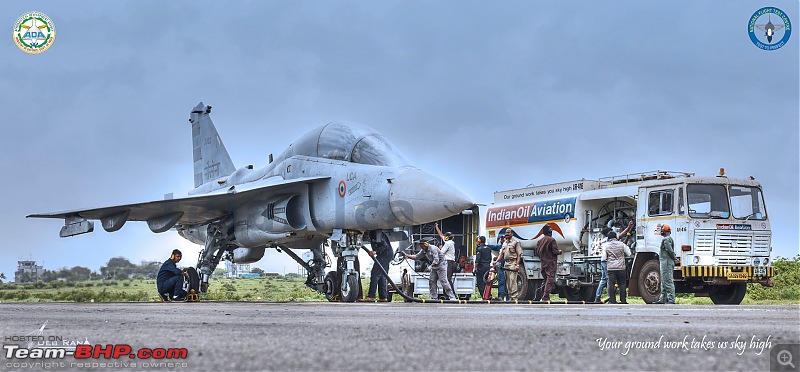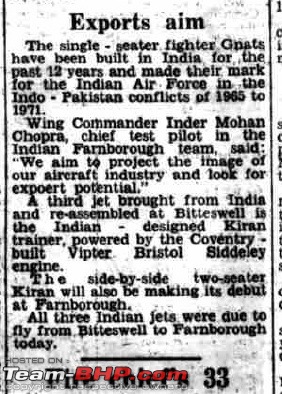Quote:
Originally Posted by Jeroen  This is from 1997. So more than twenty years ago. How do current F15/16 hold out to current MIG 29versions? |
Taking stock of the situation:
F-15 Eagle: Changing trends in warfare saw the USAF forget the "not a pound for air-to-ground" motto and put in a lot of pounds for the air-to-mud role, thus devolving from the deadliest warfighter ever built (no Eagle has ever been bought down in air-to-air combat) to a strike aircraft with some self defense capabilities. I'd even bet on a F-15C/D to win against any modern F-15 variant.
F-16 Fighting Falcon/Viper: The F-16s evolution was consistent with their role of a light weight air defense fighter. Over the years it became more potent and the F-16IN offered to India for the MRCA is probably the meanest Viper built
MiG-29 "Fulcrum": The MiG-35 that was a contender for the MRCA was the finest refinement of the Fulcrum, complete with the Zhuk-AE AESA radar and the improved OLS-35 optical systems combined with 3D thrust vectoring. (The current production MiG-35 is a wimp when compared to the one that debuted in the 2007 Aero India)
1997: The Eagle is 25 years old in 1997, the Viper is 23 years old and the Fulcrum is 20. When these were designed the A2A missiles were in their fledgling years, not yet mature to be the ultimate decider in air combat. Energy rich and agile aircraft could kinematically defeat a 70's or 80's A2A missile easily, so these aircraft were designed to be powerful and yet graceful fliers. Toward's the end of the 80's the missiles took some massive leaps in terms of sensor technologies and maneuvering capabilities. The PoK (
https://en.wikipedia.org/wiki/Probability_of_kill) increased A and F poles (
https://en.wikipedia.org/wiki/Air-to...le#Performance) became larger making the fighters more vulnerable to the "sticks". In the current century, it is unlikely that two modern aircraft will engage in a gunfight to assert dominance, in all likelyhood the encounter will be initiated and settled Beyond Visual Range (BVR). Put in different words, today's fighters are more of glorified missile carriers, their job is to get to F-Pole earlier, launch and wait for the outcome. The one who sees first and shoots first is more likely to go home and talk about it.
2018: Missiles have advanced even further, the quantum leaps in processing power have made them formidable adversaries, they are more resilient to countermeasures and have better aerodynamics these days. The Israeli fifth generation Python missiles are rumoured to have target reacquisition capabilities in certain scenarios following an initial miss - something that was not possible so far outside of Hollywood.
When it comes to a mano-e-mano between an USAF F-16IN and a VKS MiG-35, the Russian multiple missile launch philosophy should give the Fulcrum the edge. The two BVR options for the MiG-35 are the R-27 Alamo and R-77 Adder missiles. Both have greater range than the AIM-120 AMRAAM (Slammer) that does duty as the F-16's long stick. In addition to the range, the Alamo and Adder have seeker modularity, the same airframe can be adapted for Radar, Imaging Infra Red and Anti-Radiation homing. If the F-16 launches a salvo of BVR missiles, it can be assumed that a flock of active radar homing birds are inbound. When the Fulcrum returns the favor, the inbound threat can be any combination of IIR, Radar or Anti-Radiation missiles. The countermeasures for each of these guidance mode variations differ and this means the end-game tactics for missile avoidance against the Russian combination is more complex. Range and modularity of the R-27 and R-77 should give Fucrum the edge in BVR. In Within Visual Range encounters, the thrust-vectoring R-73 Archer is a little more deadly than the AIM-9 Sidewinder. Once again it will all boil down to who sees first and shoots first, all things being equal, the better range and manueverability of the Archer should sway the encounter in its favor. If it ever comes to a gun fight, the 3D thrust vectoring twin engined Fulcrum is way more maneuverable than the Viper. If it ever comes to running away from a fight, the MiG has the speed advantage over the Viper.
The MiG-29 was designed to defeat the F-16 and over the ages I'd say it retained its edge, mostly thanks to its missile advantage!
(For the comparison I'd used the most advanced missile variants, avionics, engines and airframe capabilities for each aircraft. All systems are assumed to be fully functional, random failures, if any, is equal for both to be fair. It is a one on one engagement with no assistance from external entities like a force multiplier or ground stations. Pilots on each side are assumed to be top in their jobs with equal amounts of training)
 (3)
Thanks
(3)
Thanks
 (8)
Thanks
(8)
Thanks

 (5)
Thanks
(5)
Thanks

 (4)
Thanks
(4)
Thanks
 (4)
Thanks
(4)
Thanks

 (3)
Thanks
(3)
Thanks
 (3)
Thanks
(3)
Thanks
 (1)
Thanks
(1)
Thanks

 (4)
Thanks
(4)
Thanks

 (1)
Thanks
(1)
Thanks

 (5)
Thanks
(5)
Thanks












